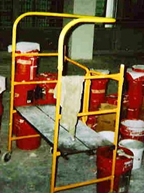- Standard Number:
OSHA requirements are set by statute, standards and regulations. Our interpretation letters explain these requirements and how they apply to particular circumstances, but they cannot create additional employer obligations. This letter constitutes OSHA's interpretation of the requirements discussed. Note that our enforcement guidance may be affected by changes to OSHA rules. Also, from time to time we update our guidance in response to new information. To keep apprised of such developments, you can consult OSHA's website at https://www.osha.gov.
January 26, 2007
Mr. Gary Chipman
P.O. Box 28
Sandown, NH 03873
Re: Subpart L; scaffolds; Companion Rail, rail extensions for mobile scaffolds; 1926.451
Dear Mr. Chipman:
This is in response to your package received by the Occupational Safety and Health Administration (OSHA) on February 13, 2006 in which you provided information about your product, the Companion Rail, pictured below. We apologize for the long delay in providing this response.



Question: You state the following: The Companion Rail is a horizontal rail attachment which is designed to be coupled and pinned to the upper frame support members of mobile scaffolds, which are typically three to five feet in height. The Companion Rail is designed to protect workers from missteps and falls off of the mobile scaffolds that are commonly used to facilitate the hanging of ceiling tiles, painting of walls and ceilings, performance of drywall work, and many other construction related activities. In addition, it is intended to provide workers with a place to grab when they mount the platform of a mobile scaffold, help the employees maintain their balance while working and serve as a place to stage their construction materials. Your question is, would the use of the Companion Rail, as described, be in violation of any OSHA scaffolding requirements?
Answer: OSHA does not approve or endorse specific products. The variable working conditions at jobsites and possible alteration or misapplication of an otherwise safe piece of equipment could easily create a hazardous condition beyond the control of the equipment manufacturer. Where appropriate, we try to provide guidance to help employers assess whether products may be used in compliance with OSHA requirements.
Section 1926.451(g)(1) of Subpart L states:
Each employee on a scaffold more than 10 feet (3.1m) above a lower level shall be protected from falling to that lower level. Paragraphs (g)(1)(i) through (vii) of this section establish the types of fall protection to be provided to employees on each type of scaffold.
Section 1926.451(g)(1)(vii) states:
For all scaffolds not otherwise specified in paragraphs (g)(1)(i) through (g)(1)(vi) of this Section, each employee shall be protected by the use of personal fall arrest systems or guardrail systems meeting the requirements of paragraphs (g)(4) of this Section.
If used to meet fall protection requirements
If the Companion Rail were placed on a mobile scaffold on which an employee was ten or more feet above a lower level to meet the fall protection requirements of Subpart L, then the Companion Rail must meet the requirements of Section 1926.451(g)(4). We have not done a comprehensive review of this product and so will not address all aspects of it with respect to the Subpart L requirements. However, we note that, as configured in the pictures provided above, the Companion Rail would not meet at least one of the requirements, 1926.451(g)(4)(i), which states:
Guardrail systems shall be installed along all open sides and ends of platforms. Guardrail systems shall be installed before the scaffold is released for use by employees other than erection/dismantling crews.
If not used to meet fall protection requirements
It appears from the information you have provided that the Companion Rail is intended to be used on mobile scaffolds of heights less than ten feet above a lower level. Under these circumstances, a guardrail is not required by OSHA, and the guardrail criteria in 1926.451(g)(4) would not apply. We caution, however, that any scaffold on which the Companion Rail is installed is otherwise subject to the requirements of Subpart L. For example, Section 1926.451(a) specifies numerous criteria for the construction and use of scaffolds. In addition, Section 1926.452(w), Mobile Scaffolds, places requirements on all mobile scaffolds, regardless of height or the presence of the Companion Rail. Care must be taken by users to ensure that the addition of a Companion Rail does not render noncompliant an otherwise acceptable scaffold.
If you need additional information, please contact us by fax at: U.S. Department of Labor, OSHA, Directorate of Construction, Office of Construction Standards and Guidance, fax # 202-693-1689. You can also contact us by mail at the above office, Room N3468, 200 Constitution Avenue, N.W., Washington, D.C. 20210, although there will be a delay in our receiving correspondence by mail.
Sincerely,
Steven F. Witt, Director
Directorate of Construction

